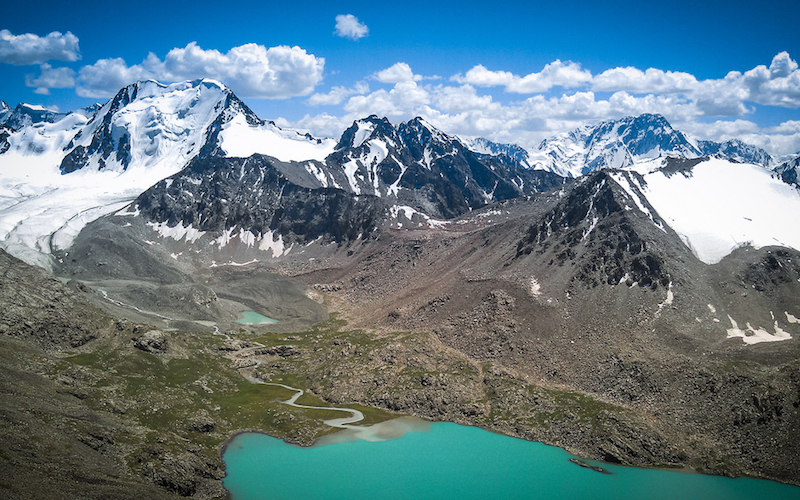
Solving Central Asia’s Water Crisis
While the adverse effects of global warming have long been a fixture of Southeast Asian politics, the repercussions of climate change in Central Asia might be just as serious. Temperatures in the region have increased by almost 2 °C since the beginning of the 20th century and at a rate of 0.3 °C per decade since the 60s, which has led to changing rain patterns and water availability. In a region that has recovered from post-Soviet upheavals, climate-induced arable land loss and desertification might exacerbate existing issues. Fortunately, some Central Asian countries have accepted the seriousness of the challenge and are taking action to reverse the trend.
Nowhere is the geopolitical dimension of global warming more evident than alongside the Tian Shan mountain range, running through Uzbekistan, Kyrgyzstan, Kazakhstan, Mongolia and China’s Xinjiang region. These mountains are Central Asia’s main water source, and are home to more than 10,000 glaciers – all of which are retreating. Indeed, studies have shown a 15-20 % total volume loss between 1960 and 2000. What this translates to is a net loss of roughly 223 million cubic meters per year, a trend that will make rivers run dry during summer time in just a few decades.
The link between poverty and climate-induced land degradation has long been an established scientific fact. Last year, environmental economists at the World Bank warned that global warming would deliver a “severe hit, with Central Asia threatened to lose up to 11% of its GDP.” Since the region is currently undergoing a major agricultural shift, as unprecedented economic growth forces agriculture to modernize rapidly, such an upheaval would be especially painful. Many former Soviet republics have repeatedly expressed serious concern regarding the issue, even leading to numerous diplomatic rows across the region.
This is bad news, since Central Asia has always been an arena of political competition. Memories of ethnic and territorial disputes, sparked by the disintegration of the resource-sharing system the Soviet Union imposed on the region until its collapse, remain vivid. Kyrgyzstan and Tajikistan, the poorest former Soviet republics, have historically provided water to Kazakhstan, Turkmenistan and Uzbekistan thanks to their abundant water resources. In return, they used to receive coal and natural gas from downstream sources. However, the demise of the USSR ultimately spelled the end of the resource-sharing deal as well.
Deprived of coal and gas imports, both Kyrgyzstan and Tajikistan started using their water supplies in hydropower plants, starving the region of water during the warm season. Naturally, this has proven to be a disaster for farmers living downstream who are dependent on steady water supplies. In response, some Central Asian countries have attempted to take control of bordering water reserves, claiming rights over strategic areas such as the Fergana Valley.
Since then, tensions have risen along the disputed Uzbek-Tajik borders. However, far from solving any underlying issues, such stress would be disastrous for Central Asia’s strained resources. Economic incentives are therefore the main reasons why these countries are working toward limiting the adverse effects of climate change. Kazakhstan, Central Asia’s heavyweight (accounting for 60% of the region’s GDP) has made a surprising U-turn for a country whose economy was primarily fueled by hydrocarbon exports. At the heart of this push for sustainability is the Astana Expo 2017, a three-month long exhibition to make the country “a global leader on the challenge of future energies” and fulfill its transition towards a “green” economy, according to Commissioner Rapil Zhoshybayev.
The EXPO seeks to encourage a debate between countries, nongovernmental organizations, companies, and the general public about ways to ensure safe and sustainable access to energy while reducing CO2 emissions. Delegations from around the world will be showcasing best energy practices that encourage global cooperation and pave the way for broader investments – with a lot of attention going to solving the exacerbating global water shortage.
Since water is a priority issue for the UN, the event has been organized in close collaboration with the UN Under-Secretary-General for Sustainable Development, Wu Hongbo. Astana will act as a center for displaying innovative ideas to solve global problems. Finland, for example, is already a world leader in water management and related technologies, and applying this know-how throughout Kazakhstan’s neighborhood could be a crucial step in mitigating the region’s water dilemma and conflict potential.
Based on the technologies on display, the EXPO is likely to advance the use of green energy across the region and increase cooperation. Kazakhstan plans to install enough renewable energy capacity to produce more than 3,000 MW by 2020, and is aiming to produce 50% its power from renewable sources by 2050. While the country’s assertive transition plan was launched before oil prices fell ($120 per barrel), the Kazakhstani government decided to nevertheless power through the crisis ($20 per barrel). Astana’s efforts have sparked similar dynamics in neighboring countries. Uzbekistan recently submitted its Climate Action Plan, which means that the Paris Agreement has reached near-universal participation. Kyrgyzstan is making the switch to the green economy as well, via investments into organic agriculture, and high-tech production of energy efficient technology.
Central Asia lays bare the threats global warming poses to peace and prosperity in a routinely overlooked part of the world. Luckily, the region has strong incentives to cooperate and alleviate pressures in order to protect their economies and secure their place as important global players. It might just be that tackling climate change will be the road to lasting peace.

